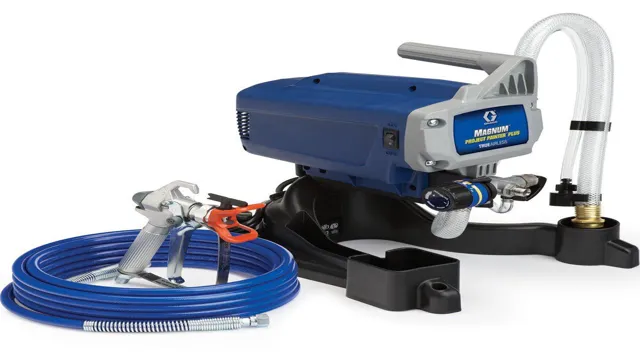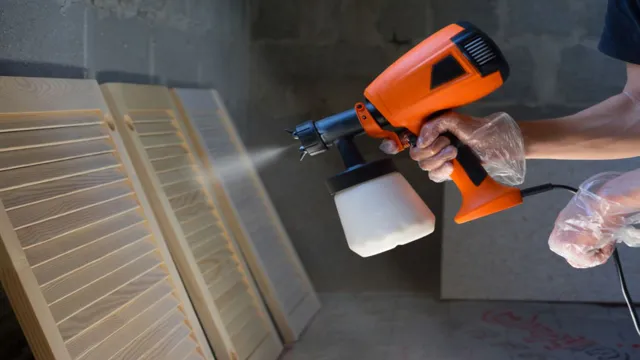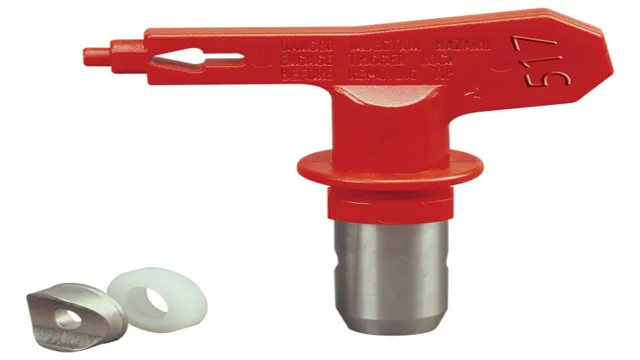How to Use a Graco 390 Paint Sprayer for Professional Results: A Step-by-Step Guide
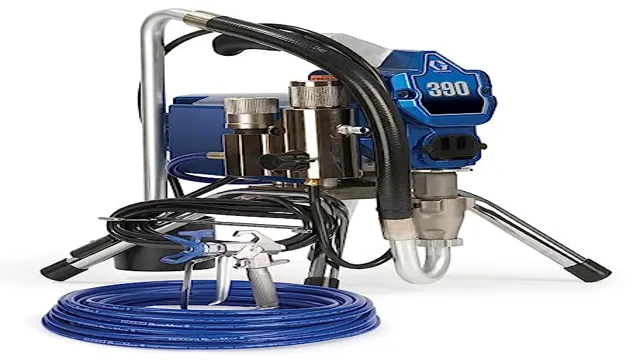
If you’re looking for a fast and efficient way to paint your walls or fence, the Graco 390 paint sprayer is a perfect tool to have. This sprayer is popular among professionals and DIY enthusiasts due to its durability and high performance. Its precision pressure control allows for a consistent and even coat of paint every time, saving you time and effort in the long run.
Whether you’re a seasoned painter or a beginner, the Graco 390 paint sprayer is easy to use and can make any painting project a breeze. In this blog post, we will take a closer look at how to use the Graco 390 paint sprayer and its various features. Get ready to become a painting pro with the Graco 390 paint sprayer!
Prepare the Surface
Before using a Graco 390 paint sprayer, it’s important to prepare the surface to ensure a smooth and even paint application. Start by cleaning the surface of any dirt, debris, or loose paint. Sand the surface if needed to create a rough texture for the paint to adhere to.
Then, use a primer to seal the surface and create a uniform base for the paint. Allow the primer to dry completely before beginning to paint. Proper surface preparation is crucial for a successful paint job with a Graco 390 paint sprayer.
Remember, the quality of the surface preparation directly affects the quality of the finished product. By taking the time to prepare the surface, you’ll achieve a professional-looking paint job that will last for years to come.
Clean the surface to be painted
When it comes to painting, the first step towards achieving a professional finish is preparing the surface to be painted. One crucial aspect of surface preparation is cleaning it thoroughly. A dirty or dusty surface can hinder paint adhesion, resulting in a patchy finish.
Before painting, remove any dirt, grime, or loose particles from the surface by washing it with soap and water or wiping it down with a clean cloth. For surfaces with grease or oil stains, use a degreaser or solvent-based cleaner. Any cracked or peeling paint should be scraped off to create a smooth surface.
By cleaning the surface before painting, you not only ensure better paint adhesion but also prolong the lifespan of the paint job, making it more durable.
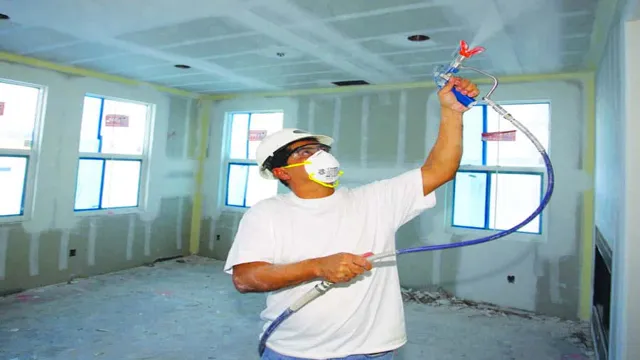
Cover surrounding areas with plastic sheets and tape
If you want to paint your walls or ceilings, it’s important to prepare the surface before you start. This includes covering surrounding areas with plastic sheets and tape to protect them from accidental splatters or drips. By doing so, you’ll avoid a lot of post-painting cleanup and potential damage to your floors, furniture, or other belongings.
Simply lay the plastic sheets on the floor, and use tape to secure them in place along the baseboards or trim. You can also cover any adjacent surfaces, such as cabinets, countertops, or light fixtures, that could get in the way or accumulate dust or debris during the painting process. When it comes to removing the tape and plastic later, it’s best to do this carefully to avoid peeling off any paint or leaving behind residue.
With a little bit of preparation, you can make sure your painting project goes smoothly, without any unwanted mess or damage.
Prepare the Paint Sprayer
Are you looking to learn how to use a Graco 390 paint sprayer? Well, the first step is to prepare the sprayer for use. This involves checking to see if there is any damage to the unit, ensuring that all the necessary parts and accessories are present, and inspecting the fluid and air hoses for any leaks or wear and tear. Once you have done this, you can proceed to set up the sprayer according to the manufacturer’s instructions.
This may involve attaching the spray gun to the hose, adjusting the pressure settings, and connecting the sprayer to a power source. It’s essential to carefully follow the instructions to ensure that the sprayer is set up correctly and safely. With proper preparation and setup, using a Graco 390 paint sprayer can be a breeze and save you time and effort on your next painting project.
Select the right tip size and pressure setting
When preparing a paint sprayer, it’s crucial to select the right tip size and pressure setting. These two factors will determine the quality of your paint job and how smoothly the spraying process will go. The tip size you choose should match the type of paint you’re using as well as the surface you’re painting.
For example, if you’re using a thin material like stain, a smaller tip size will produce the best results. However, if you’re painting a large surface area, a larger tip size will help you cover more ground quickly. As for pressure settings, it’s important to start with a low pressure and gradually increase it until you achieve the desired coverage.
Too much pressure can cause overspray and lead to an uneven application. By taking the time to select the right tip size and pressure setting, you’ll be on your way to a professional-looking paint job.
Fill the paint container with paint
If you want to start using a paint sprayer to make your painting jobs easier and faster, the first step is to prepare the tool carefully. One of the most important steps is to fill the paint container with paint. But how much paint should you add? Most spray guns come with a recommended paint capacity that you should follow, so make sure to check before pouring the paint in.
It’s also essential to strain your paint before filling the container to avoid clogging the spray gun with any impurities. Additionally, you can add a paint thinner or a conditioner to the mix to make the paint flow easier and smoother. Mix the paint well to ensure the additives distribute evenly.
Remember, following the manufacturer’s instructions and guidelines is vital to achieve the best results possible. By filling the paint container accurately, you’ll be ready to start your painting project with your newly prepared paint sprayer.
Prime the machine and test spray on a scrap material
Before starting your painting project, it’s important to properly prepare your paint sprayer to ensure smooth and even application of paint. Begin by priming the machine and testing the spray on a scrap material. This will help you identify any issues such as clogs or uneven spray patterns before you start painting your desired surface.
To prime your paint sprayer, fill the container with your chosen paint and attach it securely to the sprayer. Turn on the machine and hold the sprayer over a waste container or scrap material as you push the paint through the nozzle until it runs smoothly. Once the machine is primed, test the spray on a scrap material that is similar to your desired surface to ensure that the spray pattern is even and the paint is being applied smoothly.
By taking these simple steps to prepare your paint sprayer, you’ll be well on your way to achieving a professional-looking paint job with ease.
Spraying Techniques
If you’re looking to level up your DIY painting game, using a Graco 390 paint sprayer can make all the difference. Not only will it help you achieve a more professional-looking finish, but it can also save you a lot of time and effort. However, mastering the spraying technique takes a bit of practice.
Start by ensuring that your paint is at the right viscosity and that your equipment is set up correctly. To get the best results, hold the sprayer about 6 to 10 inches away from the surface you’re painting, moving in a smooth, steady motion. It’s essential to maintain a consistent speed and angle to avoid overspray or uneven coverage.
Take your time, and don’t rush the process. By following these steps and fine-tuning your technique, you’ll be able to achieve a flawless finish with your Graco 390 paint sprayer.
Hold the sprayer at the correct distance
When it comes to achieving the perfect spray pattern, holding the sprayer at the correct distance is crucial. Whether you’re painting walls or applying pesticides to your crops, the distance between the sprayer and the surface can make or break the final result. But what is the ideal distance? Well, it depends on the sprayer and the type of spray you’re using.
As a general rule of thumb, though, you should hold the sprayer between 6 to 12 inches away from the surface for fine finishes, and up to 18 inches away for larger spray patterns. Additionally, you should always keep a consistent distance throughout the application process. Holding the sprayer too close can result in drips and an uneven finish, while holding it too far can cause the spray to disperse too much, leading to wasted product and poor coverage.
So, take your time, practice your technique, and remember to keep the sprayer at the right distance for optimal results.
Spray in smooth, even strokes
Spraying Techniques When it comes to spray painting, the key to achieving a flawless finish is in the way you apply the paint. One of the most important spraying techniques to master is the smooth, even stroke. To achieve this, it’s essential to maintain a consistent distance between the spray tip and the surface, typically around 6-8 inches.
Remember to keep your wrist locked and move your whole arm in a sweeping motion for larger areas. For smaller objects, use short, controlled bursts of paint, moving in a back-and-forth motion. Painting should be done in a well-ventilated area, and a respirator should be worn to avoid inhaling any fumes.
By following these simple spraying techniques, you can achieve a professional-looking finish with confidence and ease.
Overlap the strokes to achieve full coverage
When it comes to achieving full coverage in your spray painting project, it is crucial to overlap your strokes. This technique ensures that every inch of the surface is covered and that there are no missed spots. One way to accomplish this is by using the crosshatch method.
Begin by spraying in one direction and then spray in the opposite direction perpendicular to the first coat. Another technique is to spray in a circular motion, starting from the center and working your way outwards. It’s essential to keep the sprayer at a consistent distance from the surface while overlapping the strokes.
If you don’t overlap your strokes, you may end up with unsightly streaks or bare spots. So, take your time, and overlap each stroke to ensure a smooth and even finish. Remember, a little extra effort in the beginning can result in a flawless end product, and who doesn’t want that?
Cleaning the Sprayer
So you’ve successfully completed your painting project with the Graco 390 paint sprayer, but now it’s time to clean the equipment. Properly cleaning your sprayer is important for maintaining its longevity and preventing clogs in the future. First, turn off the paint sprayer and disconnect it from the power source.
Then, remove the spray tip and filter from the sprayer and soak them in warm water with a cleaning agent specifically designed for paint sprayers. Next, using a clean container, run cleaning solution through the sprayer until the solution runs clear. Be sure to follow the manufacturer’s instructions for the specific cleaning solution to use.
Finally, clean the exterior of the sprayer with warm water and a clean cloth. Remember, maintenance is key to ensuring your Graco 390 paint sprayer continues to perform perfectly for all of your future painting projects!
Flush the system with water or solvent
When it comes to cleaning your sprayer, it’s essential to flush the system with water or solvent regularly. This helps to remove any leftover chemicals or paint and ensures the sprayer performs at its best. First, empty the sprayer of any remaining paint or solution.
Then, fill the tank with water or the recommended solvent, depending on what was previously used. Attach the sprayer to a clean bucket or container and turn it on. This allows the fluid to flush through the system, dislodging any leftover paint or residue.
Repeat this process until the water or solvent appears clean when it comes out of the sprayer. Not only does cleaning the sprayer keep it in good condition, but it also prevents any unwanted chemicals from contaminating future projects. Make sure to clean your sprayer after each use and keep it well-maintained to maximize its lifespan and performance.
Disassemble and clean the component parts
Cleaning a sprayer requires careful disassembling of all component parts. Start by removing the nozzle and any other detachable fittings. Next, soak these parts in a solution of warm water and dish soap to dissolve any build-up of paint or other material that may have accumulated.
Use a soft-bristled brush to scrub away any stubborn spots before rinsing thoroughly with clean water. The main body of the sprayer needs to be cleaned inside and out. This might involve removing the motor or pump, depending on the model of the sprayer.
Again, use warm soapy water to gently clean the interior, taking care not to damage any of the parts or wires. Pay particular attention to any filters or screens, such as the suction filter, which can easily become clogged with debris. After cleaning all the component parts, rinse everything with clean water and allow it to air dry completely before attempting to reassemble.
Check all the connections and ensure everything is put back together correctly before attempting to use the sprayer again. Properly maintaining and cleaning your sprayer will prolong its lifespan and ensure it continues to operate effectively, saving you both time and money in the long run.
In conclusion
In conclusion, learning how to use a Graco 390 paint sprayer can be a game-changer in your painting projects. With its powerful motor and versatile performance, it can make your painting tasks faster, smoother, and more efficient. However, it’s crucial to follow the manufacturer’s instructions and safety precautions, as well as proper maintenance and cleaning procedures.
By doing so, you can ensure optimal performance and longevity of your Graco 390 paint sprayer. Whether you’re a professional painter or a DIY enthusiast, the Graco 390 can be a valuable tool that can help you achieve your painting goals with ease and precision. So, don’t be intimidated by its size or power and give it a try.
Who knows, you might be surprised at how much you can accomplish with this top-of-the-line paint sprayer!
Proper use and maintenance of your Graco 390 sprayer will ensure a professional finish.
In conclusion, proper use and regular maintenance of your Graco 390 sprayer are crucial to achieving a professional finish for your painting project. Investing in high-quality equipment is only the first step towards ensuring the best results. Understanding the appropriate techniques for spraying and cleaning your sprayer is equally important.
Neglecting regular maintenance can lead to poor performance and costly repairs down the line. By taking the time to learn how to use and maintain your Graco 390 sprayer, you can guarantee the longevity of your machine and consistently achieve a smooth and flawless finish. Remember, taking care of your equipment is an investment in the quality of your work! So, don’t shy away from proper maintenance and usage techniques, and make the most of your Graco 390 sprayer.
Conclusion
And that, my friends, is how you paint like a pro with the Graco 390 paint sprayer. Remember, prep work is key, practice makes perfect, and always clean your equipment thoroughly. Now go forth and paint with confidence! Just make sure you don’t accidentally paint your pet goldfish.
.. trust me, it’s happened before.
“
FAQs
How do I set up my Graco 390 paint sprayer?
To set up your Graco 390 paint sprayer, start by filling the paint container with your desired paint. Then, connect the spray hose to the sprayer as well as the paint container. Finally, plug in the sprayer and you’re ready to go!
Can I use my Graco 390 paint sprayer with multiple types of paint?
Yes, the Graco 390 paint sprayer can be used with a variety of paints including latex, acrylic, and enamels. Just make sure to clean the sprayer thoroughly before switching between types of paint.
How much pressure do I need to use for my Graco 390 paint sprayer?
The pressure required for your Graco 390 paint sprayer will depend on the type of paint and the surface you’re spraying. It’s recommended to start at a low pressure and gradually increase as needed.
What size tip should I use on my Graco 390 paint sprayer?
The size of the tip you use on your Graco 390 paint sprayer will also depend on the type of paint and surface you’re spraying. It’s recommended to refer to the manufacturer’s specifications for the correct tip size.
How do I clean my Graco 390 paint sprayer after use?
To clean your Graco 390 paint sprayer after use, first, follow the manufacturer’s instructions for flushing out any remaining paint. Then, disassemble the sprayer and clean each individual part with warm water and soap or a specialized cleaning solution.
How often do I need to maintain my Graco 390 paint sprayer?
It’s recommended to perform routine maintenance on your Graco 390 paint sprayer after each use. This includes cleaning the sprayer, checking for any wear and tear, and replacing any worn out parts.
Can I use my Graco 390 paint sprayer for commercial use?
Yes, the Graco 390 paint sprayer is suitable for both residential and commercial use. It’s durable and designed for heavy-duty spraying applications.

